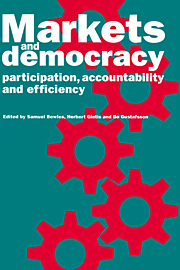Book contents
- Frontmatter
- Contents
- List of figures
- List of tables
- Preface
- 1 Post-Walrasian political economy
- Part I Agency, incentives, and democratic accountability
- 2 The democratic firm: an agency-theoretic evaluation
- 3 Alternative employment and payment systems
- Part II Institutions and institutional change
- Part III Conditions for the success of the democratic firm
- Part IV Productivity, distribution, and power
- Part V Ownership, participation and capital markets
- Part VI Political democracy and economic democracy
- Bibliography
- Author index
- Subject index
3 - Alternative employment and payment systems
Published online by Cambridge University Press: 05 March 2012
- Frontmatter
- Contents
- List of figures
- List of tables
- Preface
- 1 Post-Walrasian political economy
- Part I Agency, incentives, and democratic accountability
- 2 The democratic firm: an agency-theoretic evaluation
- 3 Alternative employment and payment systems
- Part II Institutions and institutional change
- Part III Conditions for the success of the democratic firm
- Part IV Productivity, distribution, and power
- Part V Ownership, participation and capital markets
- Part VI Political democracy and economic democracy
- Bibliography
- Author index
- Subject index
Summary
Wage employment: fixed rate, subjection, and job insecurity
The standard employment contract has three main features:
(i) A fixed rate (whether in money or in indexed contracts, targeted in real terms) per unit of time at a monitored effort supply above a minimum level.
(ii) Subjection to the employer's authority in the workplace.
(iii) Job insecurity (i.e., exposure to unemployment risk), depending among other things on the enterprise's success or failure.
Alternative employment and payment systems involve modifications of these three features, introducing:
(i) Profit-sharing or payments related to other indicators of enterprise performance (e.g., group productivity in physical terms, sales, value added); this includes collective participation in enterprise capital (Employee Stock Ownership Schemes or Trusts, ESOPs and ESOTs). Personal share ownership (PEPs in the UK) and wage-earners' funds at national or regional level (such as the Meidner Plan or its blander implementation in Sweden) do not alter the fixed nature of earnings with respect to the performance of the employee's enterprise.
(ii) Workers' participation in enterprise decision-making, which we could call power-sharing (as in the German-style Mitbestimmung).
(iii) Job security.
Permutations of the employment contract
There are only eight possible combinations and permutations demonstrating the presence or absence of profit-sharing, power-sharing and job security; all are actually observed or have been proposed, and their main types are illustrated in Table 3.1. Of course each combination contains any number of alternative degrees of intensity of any of the three features actually present.
- Type
- Chapter
- Information
- Markets and DemocracyParticipation, Accountability and Efficiency, pp. 40 - 48Publisher: Cambridge University PressPrint publication year: 1993
- 1
- Cited by



